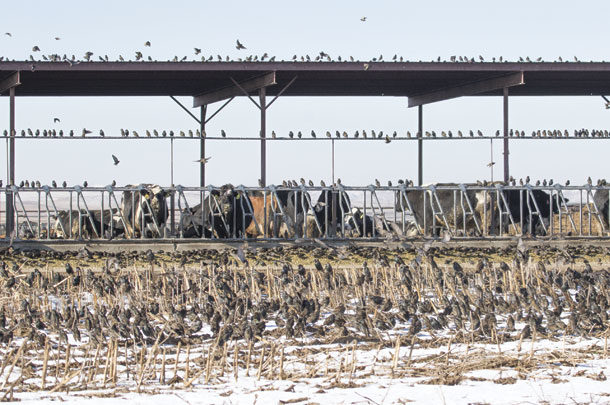To read this in French, click here.
This year marks eight years of progress in pest bird management research in my laboratory. Eight years ago, I asked a group of dairy farmers my typical question, “What keeps you up at night?” This question is traditionally met with responses about things I cannot help with, such as the milk price or the cost of feed. Eight years ago, that was not the case. Instead, I heard stories about dairies with thousands of pest birds that ate and spoiled feed, all while depositing fecal matter throughout the barns. A few farmers shared that they estimated their annual losses to be approximately $200,000 – just from feed loss. I was baffled. Why was this the first I was hearing about this problem? Why was there so little research on what appeared to be such a big problem? What could I do to help?
Eight years ago, I made a commitment to help dairy farmers find answers to this wicked pest bird problem. Step one was to build a team of experts. Our team included Professor Karen Steensma, a wildlife biologist and dairy farmer; Dr. Stephanie Shwiff, a research economist; and Dr. Susan Kerr, a livestock veterinarian. Step two was to calculate a better estimate of the economic losses caused by pest birds on dairies. Based on a survey of Washington dairy farmers, the cost of feed loss from bird consumption and spoilage equated to $55 per cow per year. Our calculations showed that pest birds caused an annual loss of $14.7 million for the Washington dairy industry. That number was shocking. It was even more shocking to consider that this very large number did not consider bird damage to buildings or the potential impact of birds on cow health.
During the next several years, we conducted research to monitor the number of pest birds on dairies, measured the nutrient loss in cattle feed from pest bird depredation, evaluated the pathogens present in pest bird fecal matter, determined whether pest bird presence at feedbunks affects cow behavior and tested the efficacy of pest bird deterrence methods. After compiling these eight years’ worth of research studies, I have five take-home messages that stand out from the rest.
1. Collect bird count data … now
You need to know how big your pest bird problem is before you can develop a management plan. Bird numbers will most likely be the highest on your farm when the weather is cold because they seek warmth in the barns and a reliable source of food – your cattle feed. Estimating the number of birds in a large group is not too difficult. The method we use is to count a group of 10 birds close together and take a mental snapshot. Then we estimate how many groups of 10 birds we are seeing. It is not a perfect count, but it gets the job done.
Besides knowing how many birds you have, knowing the species is equally important. In our survey of dairy farmers, a couple of farms reported more than 50,000 birds present in one day. The most common bird species reported included European starlings, pigeons, crows and sparrows. Once you have a decent estimate of the bird population on your farm, you can take meaningful action.
2. Conduct a cost-benefit analysis for bird deterrence
Now it is time to estimate – to the best of your ability – how much damage pest birds are causing your farm. Feed loss is the easiest one to start with. If you do not have a good estimate, you can use our average of 4.4% of feed loss from bird depredation and spoilage. Next, attempt to estimate any damages to your buildings from pest birds. Fecal matter from birds can corrode building structures. These two types of damage/losses are the only ones we can really estimate. The potential link between pathogens present in bird fecal matter and cow health is not understood well enough for us to attribute any cow treatment costs to bird-related economic losses.
Now you should have an estimate of the amount of bird damage on your farm. How does that correspond to the cost of your preferred bird deterrence method? I know plenty of farmers that prefer shooting birds as their preferred method of deterrence because it is relatively cheap – especially if you are a good aim and do not shoot up your barn – but shooting is not very effective. After you conduct your cost-benefit analysis, you may decide you need to invest a little more into your bird deterrence methods. You also may realize that what you are doing now is working. If that is the case, then keep up the great work.
3. Watch out for bird-related pathogens
The amount of data we currently have linking cow health to pest birds is lacking, but what we do know is that Campylobacter jejuni is found in wild bird fecal matter. In fact, some studies reported that up to 50% of their bird fecal samples contained Campylobacter jejuni. This pathogen poses a health risk to you and your cattle. You might remember hearing about the campylobacter species in regard to foodborne diseases. Of course, salmonella and Escherichia coli are other potential pathogens of concern found in bird fecal matter.
4. Implement deterrence methods in the summer
Although the number of pest birds on your dairy likely peaks during the cold weather in winter, implementing bird deterrence methods during the summer is key to success. Birds are as unpredictable as the weather. Once the first cold snap of weather blows through, birds start looking for a warm place to call home for the winter. This means they establish a location for their night roost. After a bird establishes its night roost, your chances of getting it out of your barn greatly diminish.
5. Consider native raptors for deterrence
Using nature to combat pest birds on your farm has become one of the most effective deterrence methods I have seen on dairies. Take a look around your farm and observe whether you have any raptors around that may help you out. Hawks, eagles, falcons and owls are all birds of prey that might give your pest bird management a boost. Raptors will either attack or chase off most pest bird species.
Attracting raptors to your farm can be as simple as installing perches in the field or placing suitable nest boxes in quiet areas around the farm. This can be a huge win-win situation, as the raptors will deter the pest birds in exchange for suitable habitats. If this method works well on your farm, it also offers itself as an environmentally friendly and socially acceptable form of pest bird deterrence.
Pest bird damage is a serious problem for many dairy farmers. My research team has several studies we are wrapping up to help you determine the best bird deterrence strategy for your farm. Stay tuned for more information in the near future.











